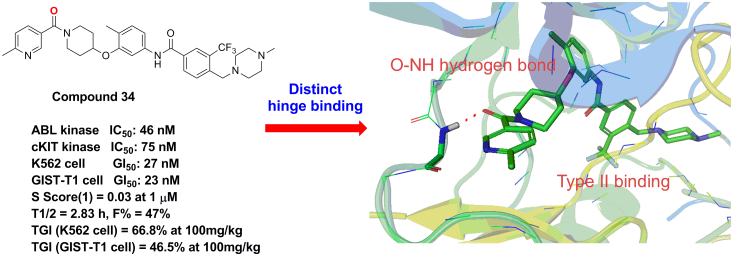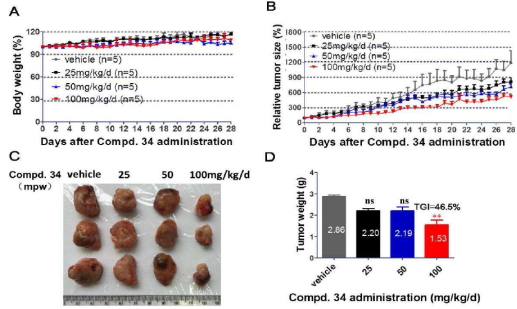
Chronic myelogenous leukemia (CML), which accounted for about 15% in all leukemia, is a kind of malignant tumor occurred in the blood system. BCR-ABL gene has been validated as the driving force in the development of CML, and it was studied as drug target for many years. And gastrointestinal stromal tumors (GISTs) are solid tumors mostly occurred in the gastrointestinal track and presented malignant property.
Recently, a research team in High Magnetic Field Laboratory, Chinese Academy of Sciences (CHMFL) led by Prof. LIU Qingsong and LIU Jing reported their new progress in developing a novel highly potent type II ABL/KIT dual kinase inhibitor CHMFL-ABL/KIT-155 with a distinct hinge binding, which exhibited a suitable biochemical and PK/PD profile in the in vitro and in vivo disease models of CML as well as GISTs.
Pathology study proved that c-KIT kinase overexpression and mutation were the main reasons for the tumor occurance and deterioration. Following their previous report of a potent type II ABL/PDGFR inhibitor CHMFL-074, the research team further explored this novel pharmarcophore extensively.
The study, this time, expanded the pharmacophore diversity of type II inhibitors and discovered a dual ABL/KIT inhibitor CHMFL-ABL/KIT-155 that utilized a hydrogen bond formed by NH on the kinase backbone and carbonyl oxygen of itself as a unique hinge binding.
CHMFL-ABL/KIT-155 potently inhibited purified ABL (IC50: 46 nM) and c-KIT kinase (IC50: 75 nM) in the biochemical assays and displayed high selectivity (S Score (1) = 0.03) at the concentration of 1 μM among 468 kinases/mutants in KINOMEscan assay and it also exhibited strong antiproliferative activities against BCR-ABL/c-KIT driven CML/GISTs cancer cell lines and arrested cell cycle progression and induced cell apoptosis.
In addition, it possessed a good oral PK property and effectively suppressed the tumor progression in the K562 (CML) and GIST-T1 (GISTs) cells mediated xenograft mouse model, which suggested that it might be a good potential drug candidate.
The results were published in Journal of Medicinal Chemistry entitled "Discovery of 4-Methyl-N-(4-((4-methylpiperazin-1-yl)methyl)-3-(trifluoromethyl)phenyl)-3-((1-nicotinoylpiperidin-4-yl)oxy)benzamide (CHMFL-ABL/KIT-155) as a Novel Highly Potent Type II ABL/KIT Dual Kinase Inhibitor with a Distinct Hinge Binding".
This work was supported by the National “Thousand Talent Program”, the National Program for Support of Top-Notch Young Professionals, the “Hundred Talent Program” of the Chinese Academy of Sciences and the National NSFC.

Figure 1. CHMFL-ABL/KIT-155 (compd. 34) with a distinct hinge binding. (Image by WANG Qiang)

Figure 2. The antitumor efficacy of CHMFL-ABL/KIT-155 (compd. 34) in K562 xenograft mouse model. (Image by WANG Qiang)

The antitumor efficacy of CHMFL-ABL/KIT-155 (compd. 34) in GIST-T1 xenograft mouse model. (Image by WANG Qiang)

86-10-68597521 (day)
86-10-68597289 (night)

86-10-68511095 (day)
86-10-68512458 (night)

cas_en@cas.cn

52 Sanlihe Rd., Xicheng District,
Beijing, China (100864)

